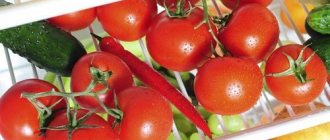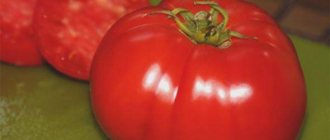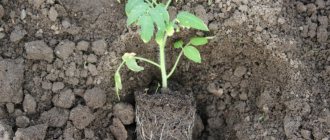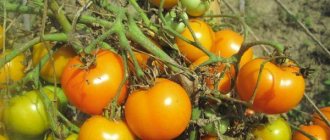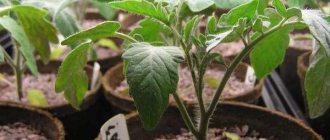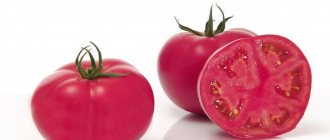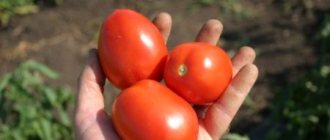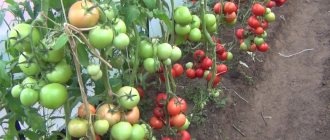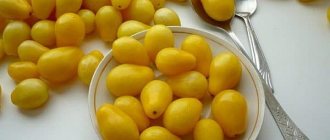Tomato Zhenaros F1 is an excellent result of Dutch selection. The hybrid is designed for 3 light zones. Highly valued for its stability and endurance, productivity and taste. Entered into the State Register in 2002.
| Height | Landing location | Ripening time | Fruit color | Fruit size | Origin | Fruit shape |
| Medium height | Greenhouse, Open ground | Mid-season | Reds | Average | Hybrid | Flat-round |
Characteristics and description of the Zhenaros variety
Tomato Zhenaros f1 has high vitality, stress resistance and disease resistance, and is resistant to late blight. The crop tolerates extremely high temperatures and sets fruit in unstable climatic conditions.
Unlike varietal tomatoes, it is impossible to obtain high-quality seeds from the Zhenaros hybrid.
The fruits have the following description and characteristics:
- glossy dense skin;
- fleshy;
- high transportability;
- round or flat-round shape;
- Red color;
- sweet taste;
- fragrant.
The weight of tomatoes is from 110 to 270 g. The shelf life of ripe fruits is 2 weeks at room temperature. Used for fresh consumption, preservation and processing.
Fruit characteristics
The growth of this species does not stop if its roots are located in the ground and climatic conditions are favorable for growth.
Indeterminate classes of tomatoes have this ability to grow. Therefore, in order for the bush to be of the correct shape, the plant must be looked after all the time and given the desired appearance by pinching. In cold summers, it is necessary to remove leaves on the bush that touch the area to prevent damage from wet soil. The entire period of growth and ripening of fruits must be tied to wooden supports, which can be ordinary wooden slats, etc. The garter will allow the plant to have a compact appearance and will prevent the disease from all kinds of diseases that are in the soil.
The Zhenaros tomato has a lot of leaves on the bush and the initial ovary appears in the cavity of the ninth leaf. In unfavorable hot months, the flowers do not fall off and form powerful ovaries due to the good heat tolerance of this variety.
tomato Erofeich - description and characteristics of the variety
The harvest can be harvested already on the 124th day from the time of planting. When properly grown, fruits show the following characteristics:
- the weight of the tomato reaches 220 grams;
- has a slightly ribbed and flat-round appearance;
- glossy skin and thick flesh;
- sweet and sour and juicy in taste.
After harvesting, ripe red fruits do not spoil for 12 days, and at colder temperatures - much longer.
Can be used in all types of preparations - juices, marinades, salads, sauces and pastes. Also suitable for pickling along with other fruits from your garden. First-class paste is produced from tomatoes of this type, and juices and various vegetable purees with the addition of tomatoes are prepared in large quantities in the industry.
The Zhenaros variety will provide you with 12 kilograms of excellent quality fruits, naturally, if all favorable conditions for plant growth are met. Tomatoes tolerate transportation well over considerable distances.
Poor soil will not be a problem for this type of tomato, but they need excellent light, although they will give you a harvest in shaded areas. According to the proposal of the Russian State Register, planting of the Zhenaros class tomato should be done in an area with a 3rd light zone.
READ MORE: Red pear tomato characteristics and yield of the variety with photos
tomato Elisey - description and characteristics of the variety
Sowing time
Since the crop ripens 120 days after planting in the soil, for light zone 3 it is recommended to sow Zhenaros seeds for seedlings in early March.
When growing in open ground, the timing of return frosts should be taken into account and sowing should be adjusted in accordance with them.
To determine the viability of seeds, before sowing they are dipped in a glass of salted water and after 15-20 minutes the surface ones are drained.
Those that have settled to the bottom are sown or pre-germinated. To do this, they are placed on a damp cloth, toilet paper or several layers of gauze and placed on a saucer. If within 2 days the seeds hatch and a root appears, begin sowing.
In addition to germination, different vegetable growers carry out pre-sowing seed treatment in different ways:
- calibrate;
- warm up;
- soaked in biostimulants;
- pickled;
- bubble;
- hardened.
Seeds of hybrid tomatoes from trusted companies usually do not require additional operations.
For planting, use any suitable container - special containers, boxes or tetrapacks with or without further picking. The soil is taken ready-made - universal for tomatoes or prepared independently from:
- 1 part of garden soil;
- 1 part humus;
- ½ part sand;
- 2 parts peat.
Add 1 tbsp to it. ash and 1 tbsp. l. complex mineral fertilizer (nitrogen, phosphorus, potassium) per 12 liters of soil mixture.
Sowing seeds is done as follows:
- a layer of soil is poured into the container:
- compact;
- water with a solution of potassium permanganate;
- lay out the hatched or dry seeds according to a pattern of 1 x 2 or 2 x 3 cm;
- sprinkle with a layer of 1-1.5 cm;
- compact;
- watered with a spray bottle;
- covered with glass or film;
- put in a warm place (+ 24 degrees).
After 5 days, the appearance of shoot loops is checked every 12 hours. If there are sprouts, remove the glass or film and place the plants in a well-lit place. If you miss this moment, the seedlings will become very elongated.
General information about the variety
The plant reliably bears fruit in greenhouse conditions and in open ground. Description and characteristics of the variety:
- mid-early, maximum variety of tomato ripening up to 124 days;
- indeterminate;
- high yield, up to 12.7 kg of berries per 1 sq. meters in greenhouse conditions;
- medium height, maximum height 70 cm;
- simple inflorescence;
- average foliage of the bush;
- the first inflorescence is formed after the 9th leaf;
- high resistance to major diseases of the nightshade family;
- heat resistance;
- good berry set;
- maximum shelf life 12 days;
- unpretentious, able to bear fruit in poor soil conditions.
The tomato is suitable for cultivation in different climatic zones. A distinctive feature of the variety is resistance to extreme conditions. In addition to Russia, it is successfully cultivated by Moldovan and Ukrainian gardeners.
- flat-round or round shape;
- high density;
- slightly ribbed;
- glossy;
- ripe berries acquire a red color;
- large, maximum weight of ripe berries is 270 grams;
- fleshy;
- sweet;
- fragrant.
Hybrid tomatoes are suitable for canning, making pastes, purees and juices. The berry will be an excellent addition to a vegetable salad.
Growing seedlings
As soon as white dots appear, remove the glass or film, place the container in a bright place and reduce the air temperature to 20-22 degrees during the day and 18-19 at night.
Daylight hours for tomatoes should be 12-14 hours, so it is necessary to provide additional illumination in the evening with LED or phytolamps.
In addition to temperature and light conditions, correct soil moisture is very important: it should not be too high, but also very dry. Therefore, watering is done with warm water as it dries: first, once every 3 days, then, as the tomatoes grow, more often. You need to water at the root, for example, from a syringe without a needle.
When 2 true leaves appear, the tomatoes can be picked. If they are sown according to the pattern of 1 x 2 cm, then this must be done, if 2 x 3 cm, it can be done later (with 4 leaves).
The Zhenaros tomato is planted in fairly large containers, since the plant is powerful and the volume of roots must be appropriate. The soil for seedlings is the same as for sowing seeds. Seedlings should be planted deep down to the true leaves.
Caring for Zhenaros tomato seedlings is as follows:
- Lighting. Daylight hours are 12-14 hours; additional lighting is provided if necessary.
- Temperature. 22-24 during the day, 18-20 at night.
- Watering. Abundant (to the entire depth of the planting container) after the soil has completely dried.
- Feeding. Carry out 1 month after picking with complex mineral fertilizer.
All these measures are aimed at obtaining strong seedlings with a powerful root system, thick stems and short internodes.
Important! If the tomatoes do not have enough light, at a constant high temperature and always moist soil, they will stretch out, the stem will become thin, the internodes will become long, and the root lobe will become small.
50-60 days after germination, Zhenaros tomatoes are planted in a greenhouse or open ground (if there is no threat of frost).
Transplanting to the garden
The main rule: the air temperature should be +16 – +18 degrees. Plants are planted at the age of 50-60 days.
Landing
It is recommended to harden Zhenaros tomatoes 2 weeks before planting in the garden. To do this, boxes with seedlings are taken out onto the balcony or open veranda for several hours a day.
Plants are planted in the beds using the square-cluster method: the bushes are planted in the corners of an imaginary square, each side of which is 50-60 cm. An irrigation hole with a diameter of 40 cm is made in the center. 1 liter of ash or a handful of superphosphate and potassium sulfate is placed on the bottom, and a beveled one is placed on top. grass without seeds and rhizomes.
For reference . It is recommended to plant tomatoes in beds where cucumbers, zucchini, carrots, cauliflower, parsley, and dill previously grew.
Despite the fact that Zhenaros is an unpretentious variety, there are secrets of caring for the plant that will increase its productivity.
Tomatoes should be watered as the soil dries with warm water under the roots. You should not allow water to get on the leaves - this can lead to late blight.
Loosening the soil and weeding are carried out immediately after watering. If roots are visible on the stem near the ground, the plant is spudded.
At least 4-5 times during the summer they are fed with potassium-phosphorus fertilizer.
The variety belongs to the tall variety , therefore, by pinching it is formed into one stem: all the stepsons are removed, 8-10 brushes are left on the main stem. The bushes are tied to pre-prepared trellises.
Diseases and pests
According to manufacturers, Zhenaros tomatoes are resistant to a whole range of diseases:
Shoots extremely rarely suffer from golden nematode galls.
Planting in the ground and caring for tomatoes
The soil for planting Zhenaros tomatoes is prepared 2 weeks in advance:
- Dig a shovel onto a bayonet while simultaneously applying mineral fertilizers at the rate of 1 tbsp. l. per 1 sq. m.
- Level with a rake.
- Make 2-3 holes of 1 square. m. and add 2-3 handfuls of humus into them.
Zhenaros tomatoes do not tolerate dense planting. Therefore, for 1 sq. m. 2-3 plants are placed.
Just before planting, the holes are spilled with a solution of potassium permanganate and the seedlings are planted. It is better not to water it before this, then the roots will immediately begin to look for water, and the tomatoes will sooner begin to grow. If the plants are stretched out, they can be planted lying down, digging up part of the stem.
Plantings can be mulched with humus, rotted sawdust, and last year's leaves.
After 1-2 weeks, when the tomatoes have become stronger, they should be tied up. Care consists of regular:
- watering;
- feeding;
- weeding;
- loosening and mulching;
- removing stepsons and lower leaves (to the ovaries);
- ventilation (in a greenhouse);
- preventive measures.
You should feed:
- in June - nitrogen, potassium and phosphorus;
- in July - potassium and phosphorus;
- in August - nitrogen and potassium.
Important! Nitrogen at the end of the growing season accelerates the ripening of fruits.
Form a Zhenaros tomato into 1 stem, leaving 9-10 bunches. 3 weeks before the end of the growing season, pinch off the tops.
Tomato Zhenaros
Description of tomato Zhenaros F1, reviews, photos
Mid-early, indeterminate, tall Dutch tomato hybrid for greenhouses. The bush is medium leafy, medium tall. The manufacturer recommends forming it into 1 stem, removing all side shoots (stepchildren).
The leaf of this tomato is of the usual tomato type, medium size, yellow-green. The inflorescence is simple, the structure is intermediate. The first inflorescence is planted above the 9th leaf, the subsequent ones - every 3 leaves.
Fruit characteristics
The fruits are round, dense, smooth, red in color at maturity, weighing 120-160 grams (up to 220 g), fleshy, good (for a hybrid) taste. These tomatoes have a universal purpose.
Productivity : in open ground up to 8 kg/sq.m, in greenhouses – up to 12.7 kg/sq.m. (with proper agricultural technology).
The tomato is resistant to tobacco mosaic virus, cladosporiosis, fusarium, late blight, verticillium and root-knot nematode.
Advantages : heat resistance , high yield and marketability, good fruit set, excellent taste, resistance to extreme conditions, root-knot nematodes and complex disease resistance.
Tomato Zhenaros F1 is included in the State Register for the 3rd light zone.
Originator : Monsanto (Holland).
How to form a Zhenaros tomato, video
If you grew Zhenaros F1 tomatoes, please write whether you liked them or not. What was the yield and taste of the fruits like under your climatic conditions? How do you rate the disease resistance of this hybrid? Briefly describe the advantages and disadvantages of this tomato in your opinion. If possible, attach a photo of the entire bush or individual fruits you grew. Thank you!
Your reviews of the Zhenaros tomato and additions to the description will help many gardeners evaluate this hybrid more objectively and decide whether it is worth planting or not.
